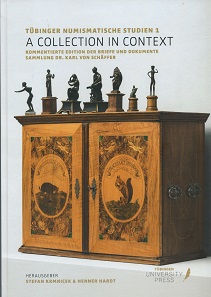by Ursula Kampmann
translated by Christina Schlögl
February 8, 2018 – Collections do not emerge in a vacuum. The collector relies on a network of suppliers. In most cases, all information on this network gets lost when the collector dies. But not in the case of Karl von Schäffer, who did not only bequeath the University of Tübingen with his coins in 1888, but he also provided the institution with all related correspondences. A team of authors has now given an account of the catalogue of written sources and portrayed the history of the collection in several essays in the first volume of the newly established “Tübinger Numismatische Studien” (Tübingen numismatic studies).
Stefan Krmnicek, Henner Hardt (Hrsg.), A Collection in Context. Kommentierte Edition der Briefe und Dokumente Sammlung Dr. Karl von Schäffer. Tübinger Numismatische Studien 1. Tübingen University Press, Tübingen 2017. 199 p. with images in black and white. 21.5 x 30.3 cm. Hardcover. ISBN: 978-3-947251-01-8.
Karl von Schäffer
Based on her doctoral dissertation, Veronika Holdau contributes a biography of the collector: Karl Friedrich von Schäffer (1808-1888) can be considered a typical representative of the coin collectors in the 19th century. He made a living as a medical director at the royal (mental) hospital in Zwiefalten and thus belonged to the intellectual elite. For them, coin collecting was a popular and respected pastime. Due to his high income, he was able to gather about 3,000 coins and medals. The collection was characterised by a high amount of expensive ancient coins. When Karl von Schäffer died in 1888 without heirs, he left this valuable possession to his alma mater.
His collection initiated a more intense study of numismatics in Tübingen, as Stefan Krmnicek and Henner Hardt tell us in their contribution. Despite the fact that the university had already been maintaining a coin collection since 1798, it was Schäffers gift, which lead the ordinary of archaeology, Ludwig Schwabe, to turn numismatics into a key discipline. And the new series of the “Tübinger Numismatischen Studien” merely illustrates that it has stayed like this until today.
Coin collecting and the coin market in the 19th century
Hadrien Rambach has written two fundamental articles – in English (!) – which shine a light at coin collecting and the coin market and all its actors in the 19th century. It is a highly interesting undertaking, since the author dedicates his articles to a crucial time in numismatic history, namely the time when the passion turned into a true scientific discipline. It is no coincidence after all, that Theodor Mommen’s fundamental “Geschichte des römischen Münzwesens” (History of the Roman coinage) was published in 1860! It was only a little more than a decade later that the first volumes of the catalogues of the British Museum were issued, which are still quoted in many areas of research until this day. New technologies, like the opportunity to send telegrams, brought the world a bit closer together.
Hadrien Rambach paints a detailed picture of this period. He provides prices and talks about the coin dealerships, collectors went to at the time. He does not only list names like Hamburger, Hirsch or Cahn, which everyone knows. Rambach develops a list of 77 German coin dealers of the 19th century. He also lists a variety of other information. It’s a task which must have truly required a lot of diligence – as everyone who has dealt with provenance will know!
The antiquities of Colonel von Wundt
Philipp Baas has published a complementary article on the collection of antique objects of Colonel von Wundt, who was in personal contact with von Schäffer. The article offers a small side glance on the antiquities trade of the 19th century.
I have received both of your valued letters along with the coins….
The centrepiece of the publication is the release of all sources related to the collection of Schäffer. And it is at this point that I pity everyone who does not speak German, since it is simply incredible to immerse oneself into the collector’s everyday life. You read about other collectors, like Mr. Imhoof from Winterthur, and understand that coin collecting could spark intense friendships at that time, just like it does today.
I would like to recommend this book to all coin collectors and all coin dealers who are not just interested in coins but also in their own history. Whether you want to read only English or only German – this book certainly offers enough interesting information!
Incidentally, the editors of the book have decided on a new method of publishing. The document is available for download as a pdf online within the framework of Open Source.
Anyone who would rather have a book in their library can get a copy with the book-on-demand-method. All information on this method is provided by Stefan Krmnicek.





